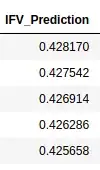I am newbie in the neural network world and actually I build my first neural network but for some reason when I use de trained model to predict ,giving by myselft the data I want it to predict it, returns me the same value even if I modify some columns value.
I describe deeper, I am trying to build a model that is capable to predict wicht machine must be planificate for the day choosen. The input data that I use for train the model has 22 attributes columns for the machine and the last column the value that I wanted to predict (IFV) that is between 0-1.
From thoose columns I pass: the weeknumber of the year, the month number, and the week day. After trying it with some executions and having the same output I one-hot the week day and divided in 7 columns more, but even with this change I still have the same value for each time.
This is my model structure:
model = Sequential ([
Dense(16, activation ="relu", input_shape=(22,)),
Dense(8, activation ="relu"),
Dense(1, activation = "linear")
])
And this is my compilation and training code:
model = get_model()
model.compile(optimizer='adam', loss='mean_squared_error', metrics=['mse', 'mae'])
my_callbacks =[
save_checkpoint_foreach_epoch('history_all_process_mse4'),
save_model_folder ('model_all_process_mse4'),
]
history_all_process_mse = model.fit(X_train, Y_train,
batch_size= 32,
epochs=20,
callbacks= my_callbacks,
validation_data=(X_val, Y_val))
model.evaluate(X_test, Y_test, verbose=2)
save_model_h5 (model, 'model_all_process_mse4')
I use this number of epochs because my trained input data is too large and I use this batch size (the default one) because in diferent searches says that have good results in general
The evaluation output is the following one:
loss: 0.0016 - mse: 0.0016 - mae: 0.0270
By the way I am using Jupyter notebooks and this is from Jupyter, and the predictions are from another Jupyter.
In the prediction Jupyter I load the model saved and prepare the new data ,with the same structure as the trained data, that i wanted the model to predict the IFV column.
The trained data like the new data is normalized and scaled in the range 0 to 1.
Load the data to predict and normalize it with MinMaxScaler (0-1):
# In this csv the date for planificate is '2021-06-04'
# Importan! --> If i change the date about 9 columns are modified
# weekNumberOfYear, month, and 7 columns for each week day (monday-sunday)
df = pd.read_csv('../data/planificationsPredictions.csv')
dataset = df.values
X_predict = dataset
X_predict_values = normalize_data(X_predict)
And the result is this one:
I know the result value is lower but for now I wanted that the output prediction values change when I change the date.
Sorry if myproblem isn't as clear as I wanted, if is not plis let me know and i will modified the question. Thanks fo reading.
